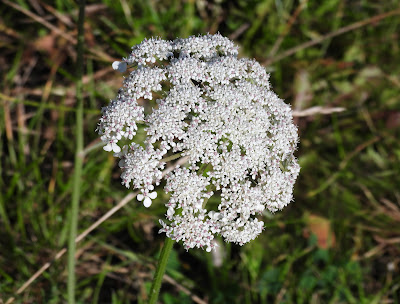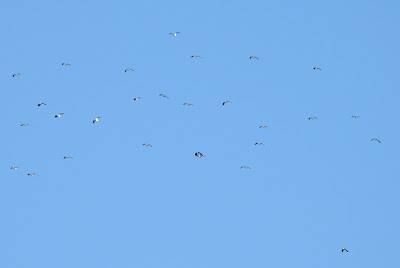I love the colours of autumn, both the defiant blooms of late flowering plants, and the yellows and reds, as the leaves change colour. The colours are so rich and deep, against the backdrop of the monochrome days of the approaching winter. It almost feels like a last hurrah before the days shorten, and the temperatures drop.
Once again, it has been nearly three weeks since I last posted, and Gail and I have been out, but unfortunately not seeing a great deal. We have been trying! We have been regularly checking the cemetery and the coastal park for things like Yellow-browed Warblers (they're everywhere this autumn), and other migrants, without any luck.
We had our first Redwings for the autumn over our garden on the night of 3rd October, and since then they have been regular on suitable nights. I haven't run my garden light trap since the night of 3rd/4th October, when I only caught four moths of four species; Red-green Carpet, Lesser Yellow Underwing, Setaceous Hebrew Character, and Diamond-back Moth. The Red-green Carpet was a new species for the garden though, so that was nice.
Just under a fortnight ago, we had a walk along the Wyre Estuary from the Quay, and lots of defiant blooms were being very showy, and contrasting nicely against the reds and browns of autumn. It really was glorious to see their bright, colourful flowers putting on one last show, and providing a late nectar lifeline for flying insects.
The rose hips were bursting with colour, splashes of a deep rich red, against a sepia background. They were also bursting with juicy, plump loveliness, that the Greenfinches will find irresistible.
Out on the mud of the quay were few waders, just 26 Redshanks and eight Oystercatchers. Close to where the boats are moored, we heard a Kingfisher calling, and it shot past the boats and perched up on a raised mound of mud that was slightly drier. I managed to get my bins on the Kingfisher briefly, and could see that it was a female, but before I could raise my camera it was off.
Further along the quayside amongst the Elder, Hawthorn and Rowans, two Dunnocks were full of migratory excitement. They were constantly calling, perching up on the top of the vegetation, or on the fence, and looking skywards. It wouldn't be long before they built up the courage, and threw themselves into the air for a short migratory hop. I have seen this many times before at this time of year. One bird I watched took several attempts at take-off, before flying round in circles, climbing at the same time, and then heading south.
On the river were six Little Egrets, and a Rock Pipit lifted off the saltmarsh giving its thin call. A few Meadow Pipits and Grey Wagtails went over heading south.
Five days ago, I headed to the coastal fields at Larkholme for an autumnal wander. As I got out of my car a male Peregrine went over heading south, and I thought, "that was a good start", but the 'Peg' would turn out to be the highlight.
Along the embankment behind the sea-wall were some gorgeous autumn colours belonging to Sea Sandwort, and Sea Milk-wort, and a few defiant blooms of Sea Campion.
I didn't have anything going over on vis, as it was a bit murky to the south and east, and I suspect the 32 Meadow Pipits in one of the wet fields were being held up. A male Stonechat added a splash of colour to the monochrome of the dunes, and a female Sparrowhawk was a bit ambitious with an attempt at a Jackdaw.
Back at the sea wall after my walk around the farm fields, two Wheatears were on the sea wall, and a lovely Red Admiral motored past.
On Monday, Gail and I had a walk down to the Wyre Estuary along the public footpath through the 'Hawthorn tunnel' as we like to call it. A group of 18 Blackbirds were feeding on Hawthorn berries alongside a Song Thrush, and five Redwings, and the Redwings perhaps indicated a Scandinavian origin for the Blackbirds.
Always on the look out, and most certainly always listening, for Bearded Tits at this time of year, we had two Cetti's Warblers giving their explosive song from some of the areas of reedbed.
As we got down to the river, Pink-footed Geese were heading west in small groups, and we had nearly 400 over. A few Jackdaws were heading south, and we had 180 in total.
Walking past the reservoir, before we got to our spot to 'scope' the river, we could hear Kingfisher calling, but sadly it would remain unseen. Out on the 'res' were eight Tufted Ducks, seven Coots, six Moorhens, and five Little Grebes.
As the tide ran in, it was corralling and flushing waders and wildfowl, and we counted 616 Lapwings, 270 Wigeons, 62 Redshanks, and 195 Teal. Out on the river a few Gulls gathered, including 270 Herring Gulls.
The incoming tide also pushed a few passerines off the saltmarsh in the form of, 14 Skylarks, six Rock Pipits, and 21 Linnets.
On our walk back to the car we admired the seed heads of Teasel, and a lovely late flowering specimen.
We haven't managed a ringing session for a couple of weeks, mainly because the days that we have been available, the weather hasn't played ball. However, at the moment the weather forecast for the weekends looks okay-ish, so we'll keep our fingers crossed.




















No comments:
Post a Comment